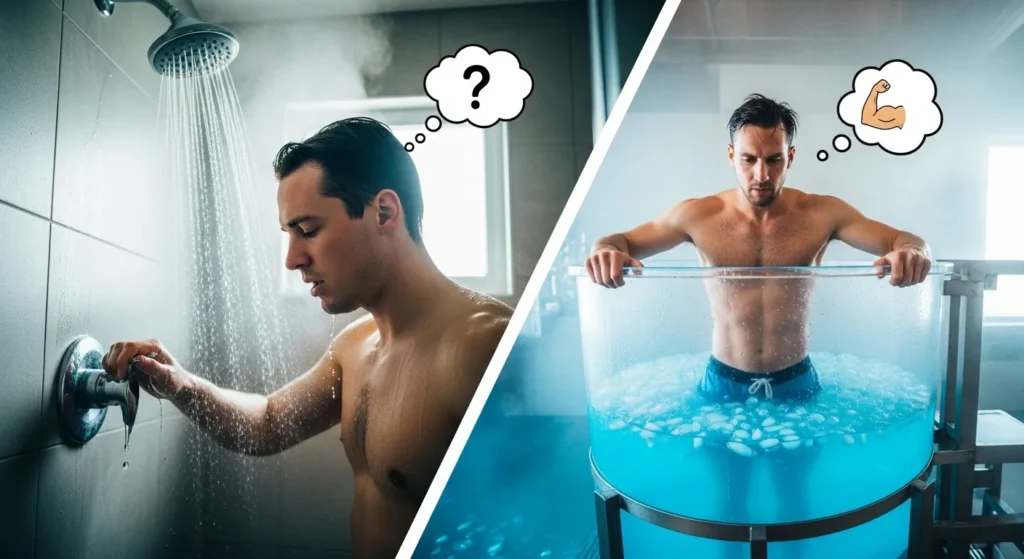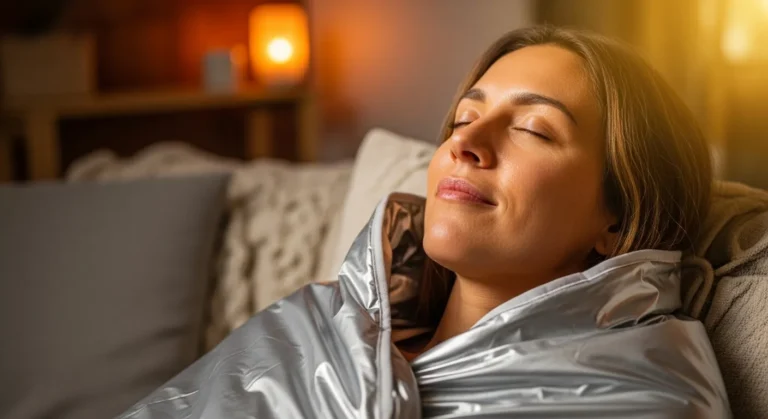Cold Shower vs Cold Plunge: Which One Actually Works Better?

Last Tuesday, I watched my neighbor emerge from his backyard ice bath, shivering but grinning like he’d just conquered Everest. Meanwhile, I was still debating whether my morning cold shower counted as “real” cold therapy. Sound familiar?
The cold shower vs cold plunge debate is heating up (pun intended), and for good reason. Research shows that water under 14 degrees Celsius can trigger up to 260% increased dopamine release and 530% increased norepinephrine release, but does it matter whether you’re standing under a showerhead or submerged in a tub?
You’re about to discover the real differences, unexpected benefits, and which method might transform your wellness routine. Spoiler alert: the answer isn’t what most people think.
Key Takeaways
- Temperature control: Cold plunges reach lower, more consistent temperatures than most home showers
- Full-body immersion delivers more comprehensive cold exposure benefits
- Cold shower benefits are real but may require longer exposure times
- Cost and convenience make cold showers more accessible for daily practice
- Both methods can improve mood, metabolism, and recovery when done consistently
The Real Science Behind Cold Water Benefits
Before we dive into the showdown, let’s talk about what actually happens when you expose your body to cold water. It’s not just about willpower or bragging rights—there’s legitimate biology at work.
When cold water hits your skin, your body activates the sympathetic nervous system. This triggers a cascade of responses: blood vessels constrict, heart rate increases, and your brain releases a cocktail of beneficial chemicals.
The key players:
- Norepinephrine: Improves focus and alertness
- Dopamine: Boosts mood and motivation
- Endorphins: Natural pain relief and euphoria
Why Temperature Matters More Than You Think
Here’s where things get interesting. Water temperature from a cold shower can only become cold to a certain degree, while water in a cold plunge tub can be cooler/icy and remain constant.
Most home showers max out around 50-60°F (10-15°C) on the coldest setting, while cold plunge tubs can maintain temperatures as low as 35-45°F (2-7°C). That 15-20 degree difference isn’t just about comfort—it impacts effectiveness.
Cold Shower Benefits: More Powerful Than You’d Expect
Let’s give credit where it’s due. Cold showers pack a surprising punch for something you can do in your existing bathroom.
The Accessibility Advantage
Cold showers win hands-down for convenience. No special equipment, no setup time, no maintenance. Just turn the dial and embrace the shock.
Daily benefits you’ll actually notice:
- Energy boost: That jolt of cold water activates your entire nervous system
- Improved circulation: Your body works harder to maintain core temperature
- Stress resilience: Regular exposure builds mental toughness
- Better skin and hair: Cold water tightens pores and adds shine
The 30-60-90 Method
Research shows those who took a routine cold rinse had a 29% reduction in sickness absences from work when they finished hot showers with 30, 60, or 90 seconds of cold water.
Start with 30 seconds and work your way up. The magic happens in consistency, not duration.
Real Talk: Cold Shower Limitations
Here’s what cold shower enthusiasts don’t want to admit: partial exposure isn’t optimal. A shower doesn’t provide constant and even exposure to the water, meaning it has less of an impact on the body compared to full immersion.
Your shoulders, back, and parts of your torso get the cold treatment, but your core body temperature doesn’t drop as dramatically. This limits some of the deeper physiological benefits.
Cold Plunge Power: The Full-Body Experience
Now we’re talking serious business. Cold plunge vs cold shower becomes a different conversation when you factor in total-body immersion.
Why Full Immersion Changes Everything
Cold plunges reach lower temperatures and more completely cover the neck and abdomen where the nerve extends, causing a greater response and ultimately a richer sense of relaxation and stress-relief.
When you’re submerged up to your neck, every inch of skin is exposed to consistent cold temperatures. This creates a more intense sympathetic nervous system response.
The Science of Submersion
What happens during a cold plunge:
- Immediate shock response: Heart rate spikes, breathing deepens
- Vasoconstriction: Blood vessels tighten, redirecting blood to vital organs
- Hormonal cascade: Massive release of norepinephrine and dopamine
- Metabolic boost: Body burns calories to generate heat
Beyond the Hype: Real Cold Plunge Benefits
Physical benefits:
- Reduced inflammation and soreness after exercise
- Enhanced recovery between training sessions
- Potential metabolic improvements (though weight loss claims need more research)
Mental benefits:
- Improved cognitive function and mood
- Greater stress resilience and mental toughness
- Extended dopamine elevation (can last hours)
Head-to-Head Comparison: The Honest Truth
| Factor | Cold Shower | Cold Plunge |
| Temperature | 50-60°F (10-15°C) | 35-50°F (2-10°C) |
| Cost | $0 (existing shower) | $100-$15,000+ |
| Convenience | Daily, 2-5 minutes | Setup required |
| Full-body exposure | Partial | Complete |
| Intensity | Moderate | High |
| Consistency | Easy to maintain | Requires dedication |
The Temperature Truth
Research shows brief immersions (5 minutes) in water less than 59°F (15°C) did increase metabolism, but most studies showing dramatic benefits use temperatures closer to 50°F or below.
This is where cold plunges have a clear advantage—they can maintain those research-grade temperatures consistently.
Which One Should You Choose?
The answer depends on your goals, lifestyle, and honestly, your budget.
Choose Cold Showers If You:
- Want to start cold shower therapy without investment
- Prefer convenience over maximum intensity
- Are building a sustainable daily habit
- Live in an apartment or have limited space
- Want to test cold exposure before committing
Choose Cold Plunges If You:
- Seek maximum physiological benefits
- Have space and budget for equipment
- Want benefits of cold plunge everyday at optimal intensity
- Are serious about recovery and performance
- Enjoy the ritual and community aspect
The Smart Approach: Progressive Cold Exposure
Here’s what we actually recommend: start with cold showers, then consider upgrading if you want more intensity.
Phase 1: Cold Shower Mastery (Weeks 1-4)
- End each shower with 30-60 seconds of cold water
- Focus on controlled breathing
- Build consistency before intensity
Phase 2: Advanced Cold Shower Protocols (Weeks 5-8)
- Increase to 90-120 seconds
- Try full cold showers 2-3 times per week
- Track how you feel and sleep
Phase 3: Cold Plunge Exploration (Optional)
- Visit local spas or gyms with cold tubs
- Consider portable tubs or DIY setups
- Compare the experience to your shower routine
Making Cold Exposure Work for Real Life
Whether you choose showers or plunges, success comes down to consistency and proper technique.
Universal Cold Therapy Rules
Before you start:
- Consult your doctor if you have heart conditions or blood pressure issues
- Never do cold exposure alone if using a plunge
- Start gradual and build tolerance
During cold exposure:
- Focus on slow, controlled breathing
- Stay calm and present
- Listen to your body’s signals
After cold exposure:
- Allow natural rewarming (no hot shower immediately)
- Move gently to increase circulation
- Notice how you feel over the next few hours
The Equipment Reality Check
Cold shower upgrades:
- Shower thermometer for temperature tracking
- Timer to track exposure duration
- Nothing else needed!
Cold plunge options:
- Budget: Large storage container with ice ($50-100)
- Mid-range: Inflatable cold tub ($200-500)
- Premium: Dedicated cold plunge unit ($2,000-15,000+)
Looking for more recovery strategies? Check out our guide to [optimizing post-workout nutrition] for complete wellness.
The Verdict: Both Have Their Place
Are cold showers good for you? Absolutely. What are the benefits of cold showers? Improved mood, energy, and resilience—all accessible in your bathroom.
Cold water benefits are real regardless of method, but cold plunges offer more intensity for those seeking maximum impact.
The best cold therapy is the one you’ll actually do consistently. For most people, that starts with cold showers.
My Personal Take
After trying both extensively, I use cold showers 5-6 days per week and visit a cold plunge facility once a week. The showers maintain my baseline resilience, while the plunge provides that deeper reset.
Why are cold showers good for you? They’re sustainable, accessible, and effective enough to deliver meaningful benefits without requiring major lifestyle changes.
But if you have the opportunity to try a proper cold plunge, do it. The experience is genuinely different—more intense, more complete, and often more transformative.
The cold exposure benefits compound over time regardless of method. Whether you’re team shower or team plunge, you’re investing in better mood, improved stress tolerance, and enhanced overall wellness.
Start where you are, with what you have. Your future self will thank you for taking the plunge—literally.
Want to maximize your cold therapy results? Check out our related articles, they show how to stack wellness habits for compound benefits.
Disclaimer: The information provided is for educational purposes only, not a substitute for professional medical advice. Always consult a healthcare professional.







